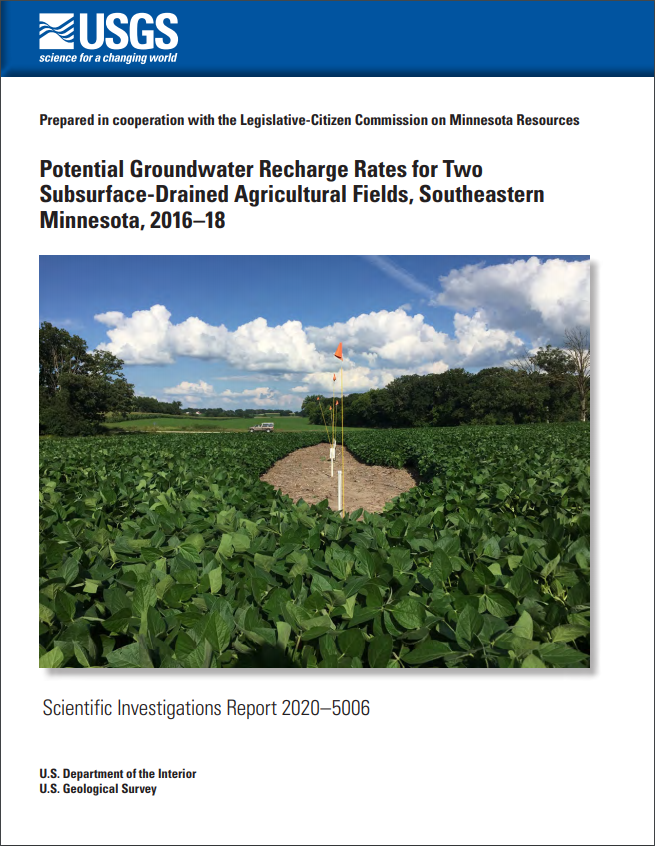The USGS recently posted a new report on the potential recharge rates for two agricultural fields that have subsurface drainage.
The report can be accessed by clicking on the button below, which will redirect you to the USGS’s website.
Abstract
Subsurface drainage is used to efficiently drain saturated soils to support productive agriculture in poorly drained terrains. Although subsurface drainage alters the water balance for agricultural fields, its effect on groundwater resources and groundwater recharge is poorly understood. In Minnesota, subsurface drainage has begun to increase in southeastern Minnesota, even though this part of the State is underlain by permeable karstic bedrock aquifers with only a thin layer of glacial sediments separating these aquifers from land surface.
To gain a better understanding of groundwater recharge effects from subsurface drainage, the U.S. Geological Survey (USGS), in cooperation with the Legislative-Citizen Commission on Minnesota Resources, led a 2-year hydrologic study to investigate this connection for two agricultural fields in southeastern Minnesota with subsurface drainage. A total of three monitoring plots were used between the two agricultural fields: two monitoring plots that included an actively drained area with peripheral, undrained areas, and a third monitoring plot without any subsurface drainage. Multiple piezometer transects were set up across the three monitoring plots to characterize the unsaturated zone and shallow water-table flow using pressure transducers and soil moisture probes. From these piezometers, groundwater recharge rates were derived using two different methods: the RISE Water-Table Fluctuation (WTF) method and the DRAINMOD model. In addition to these two methods, the USGS Soil-Water-Balance (SWB) model was used to estimate potential recharge rates for three different monitoring plots.
In addition to deriving groundwater recharge rates, the hydrologic budget was analyzed to interpret the water-table surface elevation and soil volumetric water content time series. At one of the two drained plots, the transects exhibited varying water-table surface elevation patterns. Frequent backflow from the adjacent ditch caused subsurface drainage flow to slow down or stop drainage through the main collector drain and cause pipe pressurization, so the closest transect appeared to be mostly controlled by the drain pressurization, whereas the farthest transect was more efficiently drained. Both of the drained monitoring plots had an elevation gradient parallel to the pattern tiles, sloping downward towards the collector drain that aggregated the parallel lines into a single drain. Because the transects were set at different gradients in the field, some of the water-table surface elevation differences were also attributed to lateral flow towards the lowest parts of the field.
Three methods were used to derive potential groundwater recharge rates: the RISE WTF method, the USGS SWB model, and DRAINMOD-derived deep seepage rates. Potential groundwater recharge rates, using the RISE WTF method, across all piezometers were 1.55 and 1.94 inches per year, respectively, for water years 2017 and 2018. More differentiation of potential recharge rates between different piezometer types occurred for water year 2018. Although the difference was slightly more than 1 inch between the drained and nondrained piezometers for water year 2018, this difference was statistically significant based on a t-test with a p-value of 0.036 (α=0.05). When looking at recharge based on distance from the drain, the subsurface drain did not affect potential recharge, although other factors such as variability in screen depths, well construction, and specific yield variability cannot be eliminated. The SWB model was also used to estimate potential recharge rates for water years 2017–18, with rates between 2.44 and 5.92 inches per year for the two drained sites, generally higher than the RISE WTF estimates. DRAINMOD-derived potential recharge rates were generally the highest of the three methods, with potential recharge rates varying from 2.07 to 9.49 inches per year.
Overall, there was a lack of agreement between the three methods. These results were not remarkable, considering the fundamental differences in the methodology for each method. However, all methods did show a fundamental difference between piezometers within the drained area and piezometers outside the drained area, including the third undrained monitoring plot. The drained areas show a lower overall potential groundwater recharge compared to the nondrained areas for all three estimates. The difference for the 2018 recharge estimates was slightly higher than 1 inch for the RISE WTF method, the difference was almost double for the nine sites for the DRAINMOD model, and the difference between the drain and undrained plots was even more significant for the SWB model.
